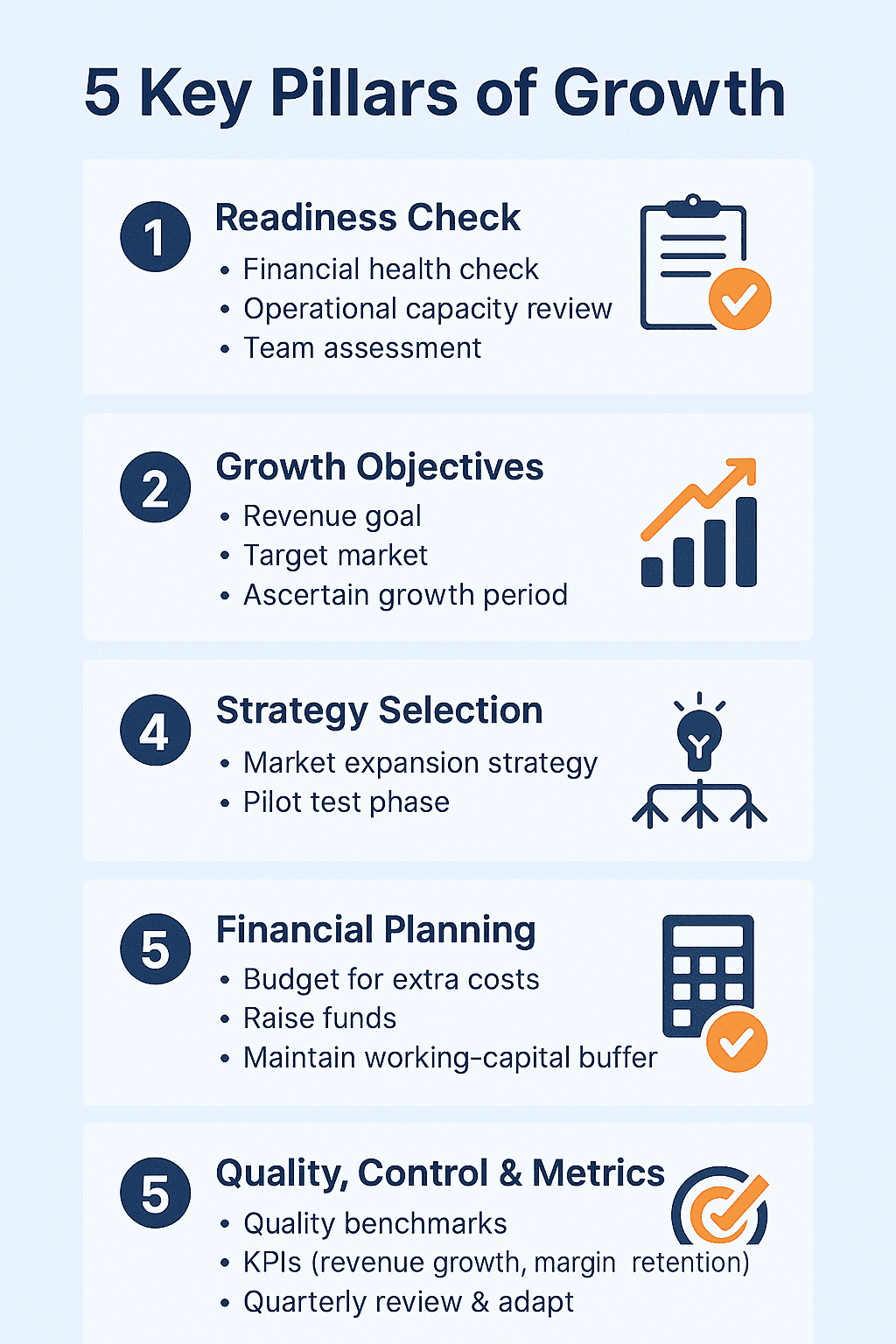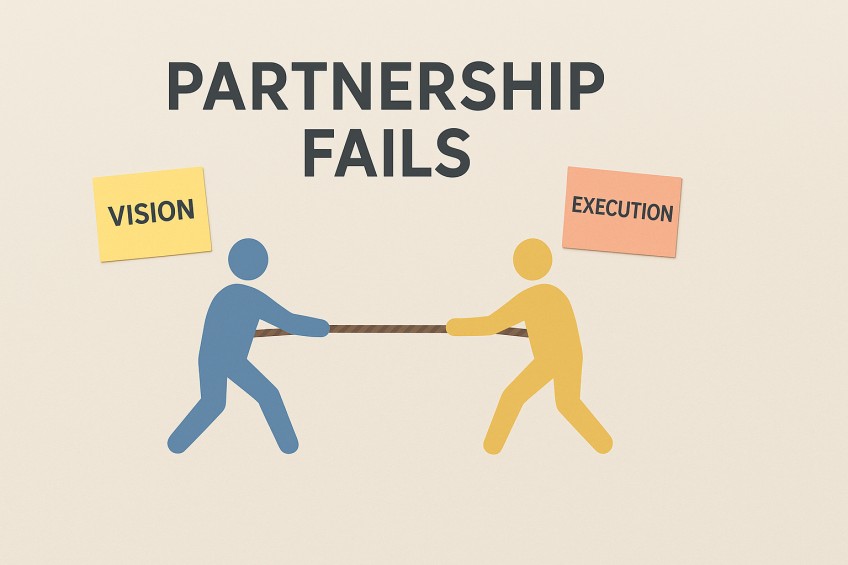The primary goal of every entrepreneur is to sustain and grow their business. It can be about gaining more customers, outlets/branches, or revenue. Scaling up isn’t just about growing fast; it’s about growing in the right direction, at the right pace. Especially in India, with its ever-expanding economy, competition is steep, and uncontrolled growth can easily lead to chaos, operational bottlenecks or even a full-fledged functional collapse.
A thoughtful business expansion plan helps you maintain a certain level of control. It means you’re not just expanding in every direction but executing according to a researched plan of action. A well-structured plan helps control product quality, manufacturing costs, overall culture and customer experience.
Let’s now take a closer look at how you can build a smart, structured expansion plan that fuels sustainable growth and supports business longevity.
Why do you need an expansion plan
Think of an expansion plan as a roadmap from point A to B. Without it, you might go off track, leading to unexpected costs, an overworked workforce, service failures, or worse: loss of brand goodwill.
An elaborate business plan gives you clarity on where you’re going, what resources you’ll need, where risks lie, and how you’ll manage them. This is crucial, especially with India’s diverse consumer behaviour across states, different legal protocols, shifting channels (offline/online) and cost overheads.
A well-crafted plan also helps boost business transparency. This helps in raising funds as investors can see that you run the business with a stable methodology.
Assessing your current business readiness
Before you expand, you’ve got to know where you stand. Here’s what to check:
- Fund Status: You should ask key questions like, How’s the business cash flow? Are you meeting your margins? And can you afford the extra cost of scale?
- Functioning bandwidth: Can the current setup bear a substantial business expansion, and if it doesn’t, what are the weak links?
- Customer feedback: Are you consistently delivering the quality that you preach? If yes, you can scale effectively. But, if it’s a no, then fix the recurring issues.
- Business culture: Is the team open to adapting with rapid growth, while maintaining a high output and operational standard?
If any of the above are a weak spot for the business, then scaling isn’t the right business move moving forward.
Defining clear growth objectives
Broad goals don’t offer much clarity. You can say that we “will grow our business fast”, but it’s a vague destination. Instead, you should implement SMART goals (Specific, Measurable, Achievable, Relevant, and Time-bound)
Instead of “growing fast”, aim for maybe,
- Increasing revenue by 20% in the next 12 months by expanding outlets to a new State.”
- Or, launching two new product lines by Q2 next year and achieving a 10% contribution from these within the first 3 months.
Clarity gives you focus. It helps you allocate resources smartly, align your team, measure success and make course corrections.
Choosing the right expansion strategy
There are millions of strategies or hacks to grow your business. Out of this, only a few can suit your individual needs, and even fewer can realistically expedite growth. Here are a few ideas to get your mind running in the right direction.
- Geographical expansion: Entering new markets, like moving from metro cities to Tier-2 cities or a new State.
- Product diversification: Offering related products or services to your existing customers.
- Franchising: Collaborating with local players or using franchise/affiliate models to expand reach with less direct burden.
- Virtual channels: Increasing your online presence, selling through marketplaces, leveraging e-commerce.
Building scalable systems and processes
Growth thrives under an organised system. Without that, unplanned expansion is like building a house of cards on a windy day.
The following are some key systems that will help you build without destabilising the business:
- Inventory management system: Ensure you can serve more customers without stock-outs or waste. Maintain ample inventory for uninterrupted services.
- Track what works: Document how things are done so they’re replicable. When you expand, you don’t want each unit reinventing the wheel.
- Customer feedback system: As you grow, you’ll need ways to capture customer feedback, respond quickly, and maintain quality standards.
- Technological tools: Use tools where possible to reduce manual errors and free your team for higher-value tasks.
The Indian SME marketplace is rapidly evolving with digital adoption. Studies show that over 70% of small businesses in urban and rural India reported business growth via digital channels. Additionally, a significant portion of the Indian MSME industry utilises tools such as ERP, CRM, and cloud platforms to streamline their operations.

Strengthening your financial foundation
Business expansion is a capital-intensive procedure. It involves extensive marketing, staff involvement, more inventory, and more infrastructure. If your financial base is weak, you’ll end up in trouble.
Here are a few key points that you can keep in mind while expanding your operations:
- Expansion funding: Plan out what you need for the next 6-12 months. This includes operational costs, contingencies, and hidden costs.
- Sourcing funds: In India, SMEs can access bank loans, private investments, NBFCs, and government schemes.
- Maintaining cash flow: As growing a business is financially exhaustive, it brings a lag in receivables or higher working capital needs. You must always keep adequate cash and monitor reserves diligently.
- Monitor cost margins: Expansion means higher costs, even if it's a temporary uptick. Track whether the added revenue is enough to offset such bottlenecks and return you to a healthy margin.
In short, as a business, you should grow not just for the sake of growth, but for sustainability and healthy functionality.
Hiring and managing for growth
Scaling a business means expanding through a team of capable people working in key positions, at optimal productivity levels.
Building a robust and competent team is a cornerstone of any successful organisation. Here are a few pointers that can help you in this regard.
- Decentralised leadership: You can’t juggle all the hats yourself as you grow. Build a leadership layer, delegate decision-making at every level, and maintain accountability.
- Core ethos: As you add teams, especially across locations, your culture can dilute unless consciously maintained. Define your core values, communicate and embody them.
- Be adaptable: Consider freelancers, remote staff, consultants for ancillary jobs, especially when expanding to new markets.
- Effective training: New team members must be aligned with your mission, quality standards and processes. It's up to you to choose and train the ones that can realistically bring value.
Leveraging technology for scale
Technology is not just a tool; it's a potent catalyst. When used effectively, it helps you manage complexity and bring control to a chaotic growth curve.
There are numerous examples of how modern tools will help guide your business’s growth. You can use,
- CRM systems to manage customers across multiple markets.
- Cloud-based inventory systems to see real-time accounts and business valuation.
- Marketing automation, like email marketing, so you don’t repeat manual tasks.
- Collaboration tools like Zoom or Skype for building a location-independent team.
Digital transformation is the linchpin of any modern business success story. Studies show digitally enabled SMEs achieve productivity gains of up to almost 30% and customer acquisition boosts of nearly 15% within a year.
Maintaining quality and control
As an entrepreneur, it's exciting to ride the growth curve. But if you compromise on quality or customer experience, you risk undoing your growth spurt, or worse.
Here are ways to stay in control:
- Set quality benchmarks, in product quality, service times, or introduce a customer satisfaction score and make them non-negotiable.
- Use regular audits as a way of maintaining strict oversight.
- Ensure there is a feedback loop, up and down the product funnel. Listen to customers and front-line staff. The more you grow, the more disconnected you become unless you maintain touchpoints.
- Use updated reports, so you see what’s going on across locations, and get a bird’s eye view of the business.
Tracking progress and adapting
Your expansion plan is not a static blueprint, but an evolving roadmap. You should track and adapt accordingly.
- Define key performance indicators: Use measurable metrics like revenue growth, profit margin, customer retention rate, cost per acquisition, etc.
- Periodic reviews: Are you meeting targets? If not, why not? What needs adjustment?
- Embrace change: Growth rarely happens exactly as you planned. Trend shifts, supply delays, and changing legal protocols bring instability to businesses. What matters is rapid adaptation, not stubbornly sticking to a failing track.
Conclusion
Scaling your business is not a sprint, but a marathon. With the right plan and mindset, you can grow confidently without compromising your control.
When you assess readiness, set clear goals, choose the right strategy, build scalable systems, hire wisely, and track your progress, you give your business the best chance of success. Using the right technology and chalking out an intentional growth plan is a critical step towards long-term growth.

















